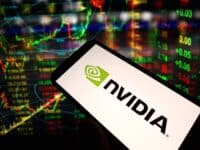

What happens when rivals become partners? We’re about to find out following Monday morning’s announcement from Advanced Micro Devices Inc. (NASDAQ: AMD) that two of its second-generation EPYC processors will be included in Nvidia Corp.’s (NASDAQ: NVDA) recently announced third-generation Nvidia DGX A100 artificial intelligence (AI) system.
[in-text-ad]
Nvidia launched the new system, which it claims is “the world’s most advanced AI system,” on May 14. The first DGX A100 system is going to the U.S. Department of Energy’s Argonne National Laboratory, where it will be used in the cluster’s AI and computing power to better understand and fight COVID-19.
Argonne researchers will use DGX A100 systems to run AI models and simulations that will help researchers explore treatments and vaccines to do years’ worth of AI-accelerated work in months or days, according to Rick Stevens, associate laboratory director for Computing, Environment and Life Sciences at Argonne.
Nvidia’s AI systems integrate eight of the new Nvidia A100 Tensor Core graphics processing units (GPUs), providing 320 gigabytes of memory for training the largest AI data sets and the latest high-speed Nvidia Mellanox HDR 200Gbps interconnects.
Does More Horsepower Also Mean More Revenues?
AMD’s EPYC business is included in its Enterprise, Embedded and Semi-Custom (EESC) segment, which posted a first-quarter operating loss of $26 million. In the prior-year quarter, AMD posted an operating profit of $68 million in that segment, but $60 million of that was attributable to a licensing gain. So maybe an $8 million quarterly profit is a more reasonable number.
In the past quarter, AMD reported that semi-custom sales were lower, although partially offset by higher sales of EPYC server processors. The slowdown in semi-custom processor sales was attributed to a ramping up of demand from Sony and Microsoft for new semi-custom processors to run new versions of gaming consoles due out later this year. As production for new chips begins to ramp up, higher production of older chips declines and causes revenues to drop.
Expenses for the quarter rose 18% year over year to $442 million due to rising costs in both company segments and an increase in stock-based compensation costs. What AMD calls marketing, general and administrative expenses rose by 17% year over year to $199 million due to increased marketing activities in both company segments.
AMD saw a sequential drop in revenue of around $450 million in the first quarter, which the company attributed to ramping up production of its latest central processing unit (CPU) and GPU chips.
AMD expects its second-generation EPYC high-performance CPUs to post year-over-year revenue growth of around 25% for the first half of 2020.
Can AMD Turn Revenue Into Profits?
EESC revenues in the first quarter of this year totaled $348 million, down by $93 million year over year. The company’s gross margin in the segment improved from 41% to 46% in the same period.
To reach a first-half profit increase of 25% year over year, AMD first has to beat 2019’s first-half revenues of $1.0 billion and operating profit of $157 million. That means revenues of $1.25 billion in the EECS segment, and that implies second-quarter revenue of $902 million. Not impossible, but unlikely based on the strength of EPYC sales.
AMD’s computing and graphics segment accounted for 80.5% of company revenues last quarter and about 150% of AMD’s total operating profit. Last year, the EECS segment accounted for nearly 162% of first-half profit.
That’s where the deal with Nvidia comes in. Nvidia will market its new AI capabilities hard, and for each system the company sells, AMD will get a piece of sales. Nvidia’s DGX A100 system carries a base list price of $199,000. While AMD’s margins on one of these systems may not reach 46%, its expenses for selling them should be reasonably low.
The third-generation server processor, code-named Milan, ramps in the fourth quarter and AMD expects to nab at least 30% of the market for server data centers with the Milan chip. Server market share gains remain critical to AMD’s long-term success, and the company expects share gains to accelerate as Milan ramps up production.
Northland Securities analyst Gus Richard expects AMD to gain market share in the server space with the launch of the new Milan processor. “We believe these products are relatively immune if the macro weakens,” he said.
A Robust Product Cycle Helps
The product roadmap for AMD’s Zen architecture continues with a fourth-generation chip code-named Genoa, due to hit the market in 2022. The first Zen product was released in 2017 and the second came out a year later. The first used 14 nanometer (nm) technology, while the second used 7 nm manufacturing technology. Milan is also a 7nm chip, but Genoa moves to 5 nm technology.
The smaller numbers indicate that the circuits on a semiconductor are smaller and closer together. The smaller the numbers, the faster the processor. Also the costliest.
AMD continues to battle Nvidia in the GPU space. Nvidia has been a leader in its development since 1999, when it launched its first GPU. Initially used in personal computers as an advance beyond the CPU, GPUs are now critical elements of advanced computing and artificial intelligence.
Nevertheless, the frenemies have now combined to release a powerful competitor in the AI and machine-learning space. As data sets grow and demand for better performance grows with it, systems like these could see a boom in demand over the next several years. AMD and Nvidia apparently believe there’s enough demand to feed both of them.
Sponsored: Find a Qualified Financial Advisor
Finding a qualified financial advisor doesn’t have to be hard. SmartAsset’s free tool matches you with up to 3 fiduciary financial advisors in your area in 5 minutes. Each advisor has been vetted by SmartAsset and is held to a fiduciary standard to act in your best interests. If you’re ready to be matched with local advisors that can help you achieve your financial goals, get started now.
Thank you for reading! Have some feedback for us?
Contact the 24/7 Wall St. editorial team.
 24/7 Wall St.
24/7 Wall St.


